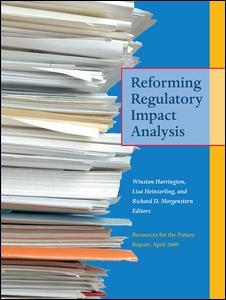Description
Reforming Regulatory Impact Analysis
Coordinators: Harrington Winston, Heinzerling Lisa, Morgenstern Richard
Language: English
Subjects for Reforming Regulatory Impact Analysis:
Keywords
epa; 2005a; cooling; water; intake; structures; clean; air; mercury; rule; IQ Loss; CWIS; MACT Standard; MACT Rule; Epa 2004c; CAIR; EPA 2005b; Epa 2005a; CAMR; Ria; Mercury Emissions; Reduce Mercury Emissions; Epa 2004b; EPA's Analysis; Cooling Water Intake; OIRA; Closed Cycle Cooling; Freshwater Fish Consumption; EPA's Estimate; IQ Point; EPA 2002a; Omb Review; Nonuse Benefits; Site Specific Comparison; EPA Estimate
· 21x28 cm · Hardback
Description
/li>Contents
/li>Biography
/li>
Preface
1. Controversies Surrounding Regulatory Impact Analysis
2. The Clean Air Interstate Rule
3. The Technocratic and Democratic Functions of the CAIR Regulatory Analysis
4. The CAIR RIA: Advocacy Dressed Up as Policy Analysis 56
5. The Clean Air Mercury Rule
6. The Mathematics of Mercury
7. The CAMR: An Economist‘s Perspective
8. The Cooling Water Intake Structures Rule
9. Improving the CWIS Rule Regulatory Analysis: What Does an Economist Want?
10. Fish Tales
11. What We Learned
Contributors
Index
Winston Harrington is a senior fellow at Resources for the Future.
Lisa Heinzerling is a professor of law at Georgetown University Law Center. She is currently on a leave of absence, serving as senior climate policy counsel at the Environmental Protection Agency.
Richard D. Morgenstern is a senior fellow at Resources for the Future.




